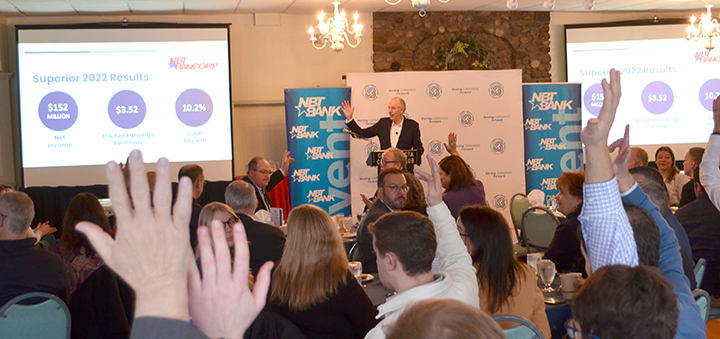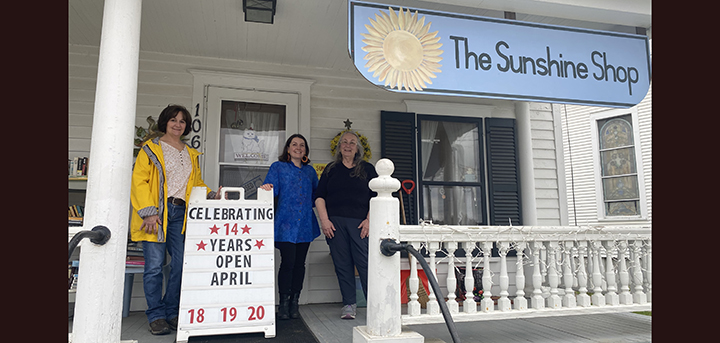Business And Community Leaders Gather For Economic Outlook Breakfast
Published:
March 6th, 2023
By:
Tyler Murphy
 NBT President and CEO John H. Watt, Jr. said community support and involvement was a key part his company’s success. He asked a room full of community and business leaders at Commerce Chenango’s Economic Outlook Breakfast at the Canasawacta Country Club in Norwich on Thursday to show their hands if they had previous experience at the bank. (Photo by Tyler Murphy)
NBT President and CEO John H. Watt, Jr. said community support and involvement was a key part his company’s success. He asked a room full of community and business leaders at Commerce Chenango’s Economic Outlook Breakfast at the Canasawacta Country Club in Norwich on Thursday to show their hands if they had previous experience at the bank. (Photo by Tyler Murphy)
NORWICH — Commerce Chenango President and CEO Sal Testani welcomed business and community leaders to the Economic Outlook Breakfast at the Canasawacta Country Club in Norwich on Thursday.
The event discussed financial challenges large and local, and was supported by Preferred Mutual Insurance Company, NBT Insurance Agency, and Chobani.
Testani said he hoped the event set a precedent for the year.
“We could not be happier with the turnout today, nor the content,” he said.
NBT President and CEO John H. Watt, Jr. began the breakfast by talking about opportunities in central New York and the bank’s recent growth.
“What a great year we’ve had because of all of your support as customers of NBT and because of all of the hard work of all my colleagues here in the room,” he said. He asked how many people in the room had worked for NBT Bank and dozens raised their hands.
“It was a very profitable year for us last year and long growth was strong. So I alluded to this in early December, we announced that NBT was going to acquire and merge with a bank called Salisbury Bank, located in northwest Connecticut in Hudson Valley and along the Berkshires in Massachusetts,” said Watt.
The merger is valued at approximately $204 million and is expected to close in the second quarter of 2023, subject to customary closing conditions, including approval by the shareholders of Salisbury and required regulatory approvals.
Salisbury is a premier community bank franchise headquartered in Lakeville, CT and had assets of $1.51 billion, deposits of $1.33 billion, and net loans of $1.18 billion as of September 30, 2022. Its primary subsidiary, Salisbury Bank and Trust Company, is a Connecticut-chartered commercial bank with 14 banking offices in northwestern Connecticut, the Hudson Valley region of New York, and southwestern Massachusetts.
Watt asked, “Why is that important?”
“So we will have 154 branches and we’ll be in excess of 2,000 employees and, oh, by the way, we’ll have a market cap of over $2 billion.”
Central NY’s $100 billion “Chip Corridor”
He added, “We have completed filling out our platform on top of one of the most crucial economic drivers in upstate New York in the next 10 to 20 years, and unlike any other competitor we have. Our footprint is fit perfectly across what we called the 'chip corridor,' with the announcement by Micron of $100 billion investment over 10 years, 9,000 jobs directly, 25,000 indirectly."
Creation of the semi-conductor facilities is predicted to create a population growth of 25,000 permanent residents in the central New York area, and will be based in Clay, New York.
“Oh, by the way, when was the last time you heard of growth in population in upstate New York? That’s great,” said Watt.
Watt cited a colleague who had the opportunity to move out of upstate New York and go to North Carolina to work, but the person resisted and shared their insight with him. "He said, ‘The chip corridor is my Erie Canal,’” recalled Watt.
“I think that is the potential here and that will ripple across the Southern Tier, it’ll ripple across the Northern Tier, and the west as well. We are in a great place to keep driving growth. What’s that growth mean for Norwich, New York? It means more employees, more services and support for all that expansion, and we look forward to it in the next 5 to 10 years.”
NBT and Commerce Chenango thanked United Way Executive Director Elizabeth Monaco for her leadership and collaboration in raising funds for the not-for-profit.
NBT Bank helped to raise about $194,785 in 2022, just counting the bank’s contributions alone.
Should I stay, or should I go?
Kenneth J. Entenmann, NBT Bank Senior Vice President, Chief Investment Officer, and Chief Economist was keynote speaker. He has over 30 years of investment experience, and for the past nine years he has provided attendees at this annual event with a timely overview of the economy and markets.
Speaking to the group of about 70 people, he said, “You’re looking at the same things I do, where being confused is kind of a permanent state of things.
“Rarely in my career have I seen economic forecasts and financial market forecasts as wide as they are.
“Looking at the economic forecast, there are economists calling for an imminent recession. They've been calling for a recession for about a year and a half now. But they are calling for a deep and dark recession because the federal reserve raised rates too high.
“And given the recent state of fairly strong economic numbers, there are economists saying we aren’t even going to touch recession, we’re just going to resume growth,” said Entenmann.
He said likewise, economic strategists had contrasting estimates for the future of the Standard and Poor's 500 in 2023, saying the market may rise or fall by 25 percent.
“A 50-percent gap? How do you reconcile these two things? It’s really difficult. Here we go.
“If I go there could be trouble, if I stay there could be double. And I really think that captures where we are today.”
Entenmann said the economy was recovering from COVID in 2021 and in early 2022, but late in the year the economy, and the recovery, began to soften.
He said Wall Street was predicting the economy was essentially looking at little to no growth in the coming year. He also pointed out the forecasts have changed drastically in recent months.
“The reality is the market is very concerned about this slow in growth. On the flip side you have slow growth, but you also have inflation that has proven really stubborn.”
He said indicators in the markets had persistently high inflation, currently around 6 percent.
“Those are all really high, and it’s kind of led to the invention of new statistics to justify that inflation isn’t as bad as it is,” he said.
He noted the consumer price index at 6.4 percent for January.
“So, they come along and say, ‘Well if we exclude food and energy, it’s only 5.6 percent. Or wait, we look at the super core, we eliminate food, energy, and shelter. Well, then inflation is only 4 percent.”
He said next year’s forum would be outside, without food or heat. “Then we can say we contributed to reducing inflation,” Entenmann said.
He said no matter what measure the Fed used, it was still more than double its own ideal target of only 2 percent inflation. In order to rein in inflation, the Fed is engaged in one of its fastest-rate cycles ever. Inflation has improved from about just under 9 percent to just over 6 percent since last year.
One change in the financial market is about a month ago they predicted the Fed would stop raising interest rates at 4.5 percent, but now markets are predicting 5.5 or 6 percent hikes or higher, adding less predictability and angst to the marketplace.
Existing home sales figures in March showed home sales are down and mortgage rates are up. Entenmann said national rates are near 6.7 percent, and “when they go above 7 percent, it’s like turning off a faucet for mortgage applications."
He called the market “sensitive.”
He said most homes are not affordable to first-time buyers.
Current home values are about 5 percent higher than a year ago, but in November 2022 prices were 20 percent higher from a year prior. So, prices are slowing.
“There is a gigantic shortage of single-family homes in the United States. Somewhere in the neighborhood of 4 million too short for single family homes. So, there is a question of just how much more that price decline can go. There is not enough supply in the marketplace. But nonetheless that home sale number is a strong softening of the marketplace.”
He also noted that increases in commodities had come down and leveled off but were still high overall. He said manufacturing sectors were slowing and operations still expensive. He pointed out strong employment and strong retail spending.
All things considered, in the end there was no such thing as risk-free. Entenmann suggested cautious optimism and said the most recent indicates were mixed, but showed a good trend.
“There are a lot of reasons to fear, but should I stay or should I go? I’m going to stay,” he said.
Author: Tyler Murphy - More From This Author
Comments






